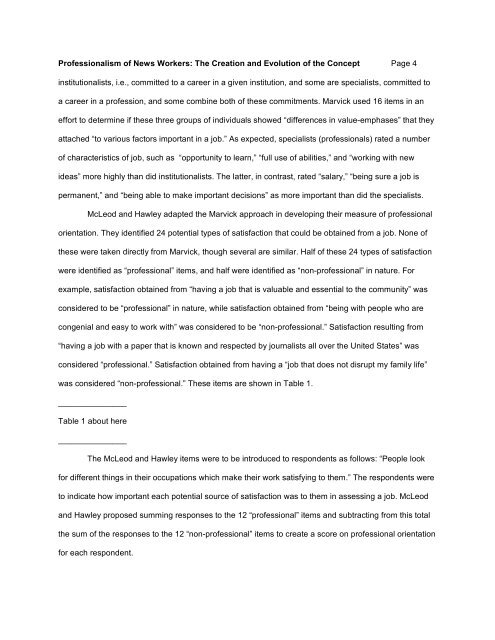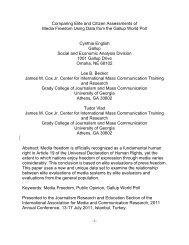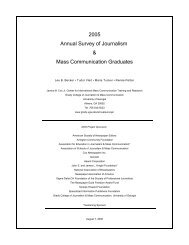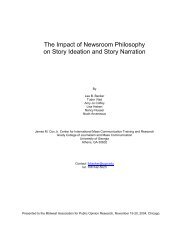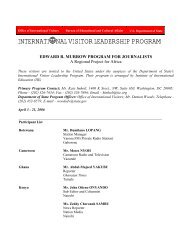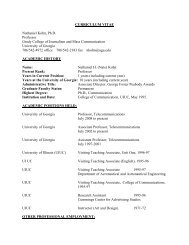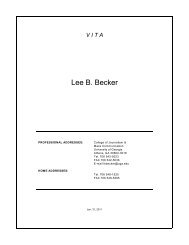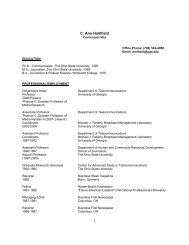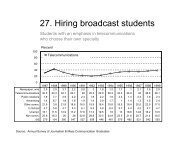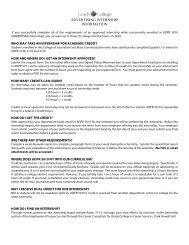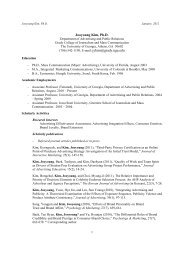Professionalism of News Workers - Grady College of Journalism and ...
Professionalism of News Workers - Grady College of Journalism and ...
Professionalism of News Workers - Grady College of Journalism and ...
You also want an ePaper? Increase the reach of your titles
YUMPU automatically turns print PDFs into web optimized ePapers that Google loves.
<strong>Pr<strong>of</strong>essionalism</strong> <strong>of</strong> <strong>News</strong> <strong>Workers</strong>: The Creation <strong>and</strong> Evolution <strong>of</strong> the Concept Page 4<br />
institutionalists, i.e., committed to a career in a given institution, <strong>and</strong> some are specialists, committed to<br />
a career in a pr<strong>of</strong>ession, <strong>and</strong> some combine both <strong>of</strong> these commitments. Marvick used 16 items in an<br />
effort to determine if these three groups <strong>of</strong> individuals showed “differences in value-emphases” that they<br />
attached “to various factors important in a job.” As expected, specialists (pr<strong>of</strong>essionals) rated a number<br />
<strong>of</strong> characteristics <strong>of</strong> job, such as “opportunity to learn,” “full use <strong>of</strong> abilities,” <strong>and</strong> “working with new<br />
ideas” more highly than did institutionalists. The latter, in contrast, rated “salary,” “being sure a job is<br />
permanent,” <strong>and</strong> “being able to make important decisions” as more important than did the specialists.<br />
McLeod <strong>and</strong> Hawley adapted the Marvick approach in developing their measure <strong>of</strong> pr<strong>of</strong>essional<br />
orientation. They identified 24 potential types <strong>of</strong> satisfaction that could be obtained from a job. None <strong>of</strong><br />
these were taken directly from Marvick, though several are similar. Half <strong>of</strong> these 24 types <strong>of</strong> satisfaction<br />
were identified as “pr<strong>of</strong>essional” items, <strong>and</strong> half were identified as “non-pr<strong>of</strong>essional” in nature. For<br />
example, satisfaction obtained from “having a job that is valuable <strong>and</strong> essential to the community” was<br />
considered to be “pr<strong>of</strong>essional” in nature, while satisfaction obtained from “being with people who are<br />
congenial <strong>and</strong> easy to work with” was considered to be “non-pr<strong>of</strong>essional.” Satisfaction resulting from<br />
“having a job with a paper that is known <strong>and</strong> respected by journalists all over the United States” was<br />
considered “pr<strong>of</strong>essional.” Satisfaction obtained from having a “job that does not disrupt my family life”<br />
was considered “non-pr<strong>of</strong>essional.” These items are shown in Table 1.<br />
_______________<br />
Table 1 about here<br />
_______________<br />
The McLeod <strong>and</strong> Hawley items were to be introduced to respondents as follows: “People look<br />
for different things in their occupations which make their work satisfying to them.” The respondents were<br />
to indicate how important each potential source <strong>of</strong> satisfaction was to them in assessing a job. McLeod<br />
<strong>and</strong> Hawley proposed summing responses to the 12 “pr<strong>of</strong>essional” items <strong>and</strong> subtracting from this total<br />
the sum <strong>of</strong> the responses to the 12 “non-pr<strong>of</strong>essional” items to create a score on pr<strong>of</strong>essional orientation<br />
for each respondent.


